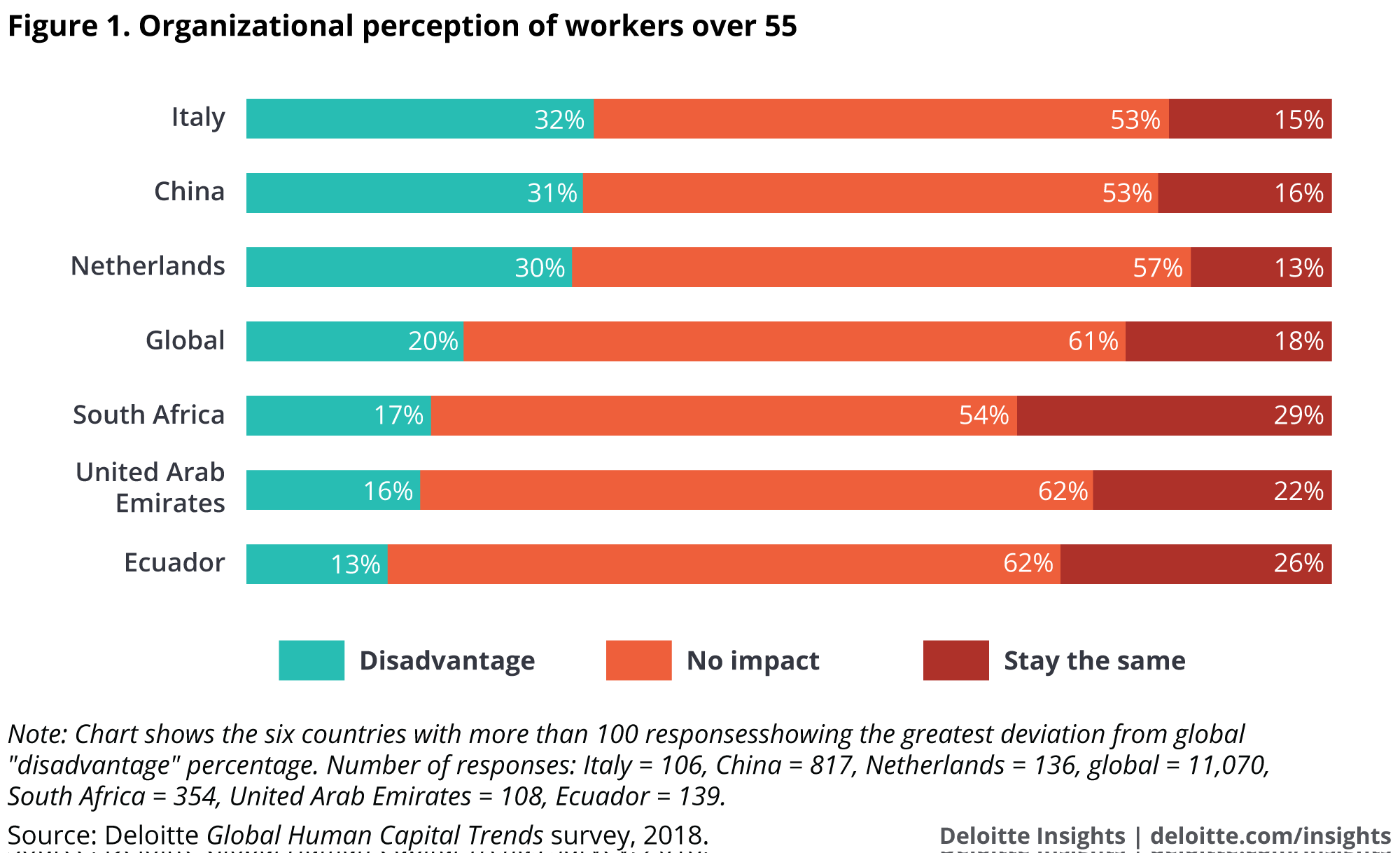The longevity dividend: Work in an era of 100-year lives
People are living longer, and organizations are shifting their attitudes toward older workers as a result. Organizations that can turn advancing worker age into an asset could gain a competitive advantage.

Longer lives, older workforces
Rising life expectancies and an aging global workforce present organizations with unprecedented challenges and untapped opportunities. Companies that plan, design, and experiment with workforce strategies, workplace policies, and management approaches for longer working lives can reap a longevity dividend. Those that lag behind face potential liability concerns and skill gaps. Creating ways for people to have meaningful, productive multi-stage and multidimensional careers is a major opportunity to engage workers across generations.
One of modern science’s greatest achievements is longevity: the unprecedented length of human lives today. Average global life expectancy has rocketed from 53 years in 1960 to 72 years in 2015—and it is still climbing,1 with life expectancy projected to grow by 1.5 years per decade.2 Longevity, combined with falling birth rates, is dramatically increasing the share of older people in populations worldwide.3 Looking ahead, the number of retirees per worker globally is expected to decline from 8:1 today to 4:1 in 2050.4
These demographic facts have profound implications for individuals, organizations, and society. In this era of longevity, an individual’s career can last far longer, spanning generations of technologies and businesses. Companies can employ people into their 60s, 70s, and beyond as the pool of traditional “working-age” (20- to 54-year-old) adults shrinks. For their part, many individuals find the need—financially and/or emotionally—to stay in the workforce past “traditional” retirement age.
In our 2018 Global Human Capital Trends survey, 29 percent of the respondents rated longevity as a very important issue, and another 40 percent rated it as important. Respondents in Japan in particular, whose population is rapidly aging, were especially concerned about the issue, with 41 percent saying that it is very important.
The looming impacts of global aging
Population aging poses a workforce dilemma for both economies and organizations. Thirteen countries are expected to have “super-aged” populations—where more than one in five people is 65 or older—by 2020, up from just three in 2014.5 These include major economies such as the United States, the United Kingdom, Japan, Germany, France, and South Korea. China’s 65-and-older population is projected to more than triple from approximately 100 million in 2005 to over 329 million in 2050.6 In fact, analysts have estimated that 60 percent of the world’s population over 65 will live in Asia by 2030.7
Compounding the challenge, almost all developed economies now have birth rates below the replacement rate of 2.1.8 This means that companies in these countries must either attract workers from abroad or tap into the maturing workforce. For a view of the challenges ahead, one needs look no further than Japan—the world’s oldest country—where a shortage of roughly 1 million employees in 2015 and 2016 is estimated to cost nearly $90 billion.9
New research is being conducted to help organizations shape their talent and business strategies for an era of longevity. The MIT AgeLab, for example, works with businesses, government, and other stakeholders to develop solutions and policies aimed at engaging the elderly population. The AgeLab uses consumer-centered thinking to understand the challenges and opportunities of longevity in order to catalyze innovation across business markets.10
Older talent as a competitive advantage
As talent markets grow more competitive, organizations often find it valuable to keep older workers on the job rather than replace them with younger ones. Our research shows that older workers represent a largely untapped opportunity: Only 18 percent of this year’s respondents said that age is viewed as an advantage in their organization. But leading companies are beginning to focus on this talent pool as a competitive advantage.
The older labor pool represents a proven, committed, and diverse set of workers. More than 80 percent of US employers believe that workers aged 50 and more are “a valuable resource for training and mentoring,” “an important source of institutional knowledge,” and offer “more knowledge, wisdom, and life experience.”11 The UK government incentivizes employers to retain, retrain, and recruit older workers, and it is committed to policies that support lifetime learning and training and decrease loneliness and social isolation.12
Proactive organizations are tapping into the older talent pool by extending their career models, creating new development paths, and inventing roles to accommodate workers in their 50s, 60s, and 70s. This year, 16 percent of the respondents we surveyed for this report say their companies are creating special roles for older workers, and 20 percent are partnering with older workers to develop new career models. Organizations could find great value in older workers’ ability to serve as mentors, coaches, or experts. Taking on these kinds of roles allows older workers to “pass the baton” to younger generations, while making room for ambitious younger workers.
Many companies are also experimenting with workplace changes to help older employees remain in the workforce. For instance, BMW increased productivity on an assembly line staffed with older workers by 7 percent in just three months through simple changes such as providing cushioned floors and adjustable work benches.13 Home Depot and other organizations are engaging older workers with flexible scheduling options and part-time positions.14 Further, as many as one-third of retirees are willing to work part-time, offering opportunities to leverage this group on a contingent or gig basis.15
Reskilling also plays a role in successful strategies to utilize older talent. One global telecommunications provider encourages senior workers to reinvent themselves and invests in programs to help them acquire new technical skills.16 Software engineers who have built careers on older technologies such as COBOL or C++ can use this experience to learn mobile computing, AI, and other technologies at a very rapid rate.
An interesting and little-known fact, moreover, is that older people are among the most entrepreneurial of workers across age groups. Between 1996 and 2014, the percentage of older workers (aged 55–64) starting new ventures increased—exceeding (by 68 percent) the rate of entrepreneurship among millennial entrepreneurs (aged 20–34), which actually decreased during the same period.17
The new challenges of an aging workforce
The transition toward older talent can present challenges. Older workers may have specialized workplace needs and can attract resentment from younger workers, and they often enjoy higher salaries because of their tenure. Organizations looking to assimilate an older worker population may face the need to design new wage policies, create more flexible rewards programs, and train young leaders to manage people across generations (including team members who may be their parents’ age).
Pensions are another area where longevity impacts organizations. The World Economic Forum estimates that a $70 trillion global retirement savings gap exists today, highlighting the sharp difference between retirement needs and actual retirement income. Moreover, this gap is projected to grow to $400 trillion by 2050.18 Helping older adults to work longer and manage their retirement savings will be a vital need for companies in order to avoid the negative productivity effects of financial stress.
Our Global Human Capital Trends research shows that many organizations are unprepared to deal with the aging of global workforces. Nearly half of the respondents we surveyed (49 percent) reported that their organizations have done nothing to help older workers find new careers as they age. Rather than seeing opportunity, 20 percent of respondents view older workers as a competitive disadvantage, and in countries such as Singapore, the Netherlands, and Russia, this percentage is far higher. In fact, 15 percent of respondents believed that older employees are “an impediment to rising talent” by getting in the way of up-and-coming younger workers.
Are older workers an advantage or a disadvantage?
Perceptions of workers over 55 years old spanned both extremes, though these perceptions varied significantly by country.
Based on these findings and our anecdotal observations, we believe there may be a significant hidden problem of age bias in the workforce today. Left unaddressed, perceptions that a company’s culture and employment practices suffer from age bias could damage its brand and social capital.
Age discrimination is already becoming a mainstream diversity issue and liability concern. More than 21,000 age discrimination complaints were filed with the US Equal Employment Opportunity Commission in 2016.19 The problem is particularly acute in Silicon Valley’s technology industry, where older software engineers are often pushed to take lower-paying jobs or look for work outside Silicon Valley because of the emphasis on the “youth culture.”20
The demographic math is undeniable: As national populations age, challenges related to engaging and managing the older workforce will intensify. Companies that ignore or resist them may not only incur reputational damage and possible liabilities, but also risk falling behind those organizations that succeed in turning longevity into a competitive advantage.
The bottom line
Staying competitive in a world of unprecedented longevity demands that organizations adopt new strategies to engage with older talent. Traditional assumptions—that learning ends in one’s 20s, career progression ends in the 40s, and work ends in the 60s—are no longer accurate or sustainable. Rethinking workforce strategies across multiple generations to account for longer lives will require open minds and fresh approaches.
3481 total views, 2 today








